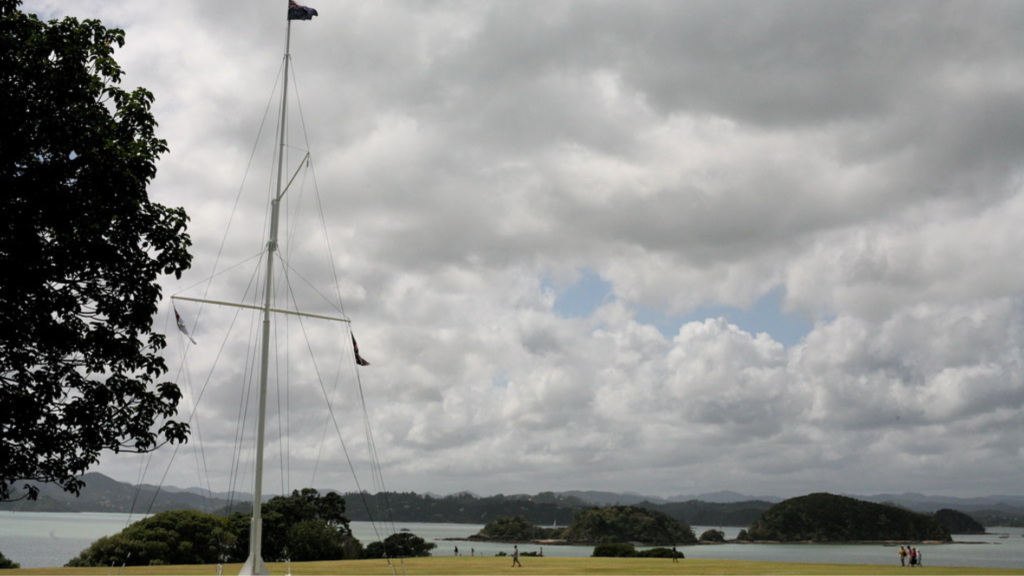Following Part 1 of the discussion about the lack of children’s picture books focused on Te Tiriti o Waitangi, Barry McLernon (Te Āti Awa & Pākehā Scottish, Dutch ancestry) and Kay Benseman (Pākehā German, Irish, Scottish, Spanish, English ancestry) kōrero about their experiences. Both are parents, educators and part of a group that meets online regularly, through Tauiwi Mō Matike Mai Aotearoa.

Kay: I had hoped to be taking my tamariki to Waitangi this weekend, I haven’t been back since becoming a Māmā, it’s such a special place.
Barry: There’s a richness in the celebration of Māori culture up there – I really felt that wairua. Listening to Dr Margaret Mutu right in the space where they signed He Whakaputanga. She was sitting on that bench talking about Matike Mai; there was something magic about that. I first visited Te Tii Marae and the Treaty Grounds at Waitangi with my tamariki in 2018. I hadn’t really experienced that until I went up there, everyone was proud to be Māori, and they felt good about their identity. It was different to Taranaki, the depth of trauma here, and there’s a lot of unpacking to do and disconnection. Our tamariki were quiet, taking it all in, but it made an impression.
K: Since my children were pēpi, we have had kōrero about our colonial heritage and responsibilities as tāngata Tiriti. We discuss colonisation and how we can limit our harm and become honourable Tiriti partners. These are not kaupapa we reserve for the 6th of February; we want our tamariki to know that it’s our Treaty, too, and what that means in our everyday lives. We talk about how important this first official agreement was between two very different groups of people, what the British Crown promised and what rangatira Māori hoped would come from it.
B: It’s my feeling that the tide is turning; there’s a swell of people wanting to engage and to have that understanding of what Te Tiriti really is and what it actually says. It’s a positive document if you really read and understand it. And understand the promises that were made, the points where it wasn’t upheld, and what that means for our country. Understanding what it means for Waitangi and the history of activism. Knowing why those things were happening.
These stories have been carried through whānau, through hapū, across time. That conscious forgetting is the privilege of the coloniser.
Joanna Kidman, (Ngāti Maniapoto, Ngāti Raukawa, Ngāti Toa Rangatira)
K: In my whānau, we say, “let’s get comfortable with our discomfort”, as that space of tension is where growth and healing may begin. I believe that if we have access to the privileges of the colonising majority at the cost of others’ well-being, we can also endure the relative discomfort we feel while learning about their experiences. Tamariki are innately inquisitive learners and their curiosity about the world is not limited to ‘easy topics’.
B: I love my daughter’s thinking at this age, she’s asking “why?” all the time! Many parents don’t like it, but I love it because ‘why?’ is such a great question. I have friends that have different perspectives to mine, and we have really honest conversations. I like it because it’s real. It’s good for me to learn about their point of view and I can say ‘this is the other side that you might not have considered’.
On why there are so few children’s picture books about Te Tiriti
K: When I talk with other educators, writers, activists and librarians about this, there are strong feelings about the need for publications for children that are iwi-led, Māori-written and illustrated. Stories that centre tāngata whenua voice, Māori lived experiences and oral histories. Asking iwi authors, experts and artists to create these books is a start, but I believe it’s important to listen to why they’re not published. I wonder about the publishing industry itself, the exhaustion of iwi Māori tired of being asked to educate tauiwi and who need to protect their energy to survive the systems of power that are so harmful. Is it still too soon?
B: This happened to my tūpuna, and I am still living with the effects of that; the land has been taken. It’s traumatic. If a Māori author publishes something, they’ve got to defend themselves to the general public, too. There are people who are gatekeeping that stuff for very good reasons and there’s tikanga involved in holding these things safely so it has to be a really careful process. It makes sense after all that’s been taken. It’d be so refreshing if you got someone that owns their positionality right from the start and are really honest. I don’t think they realise that it might be quite important to do that. I think this is the mahi that non-Māori especially are required to do as a starting place to begin the journey of honouring Te Tiriti. By stating our positionality, we can start to own our relationship with our history of colonisation in Aotearoa and develop tools to deconstruct the process that has caused us to live with a colonised mindset.
We’re living in the aftermath of those histories where the implications are still being lived by people, they’re living with the realities today … And looking at those experiences even generations down the track, the anguish is still very present in many communities. The memories in many tribal communities are incredibly strong and they don’t always match up with those of the state.
Joanna Kidman, (Ngāti Maniapoto, Ngāti Raukawa, Ngāti Toa Rangatira)
K: Thankfully, the government now recognises the need for quality, accurate teaching of these issues with the new Aotearoa Histories Curriculum. But there must also be funding directed at iwi experts, authors, artists and researchers to create rauemi to tautoko the teaching and learning of this content. Both for kaiako in primary classrooms as they begin to teach the new curriculum, and for whānau at home as they support their children in their learning at school.
B: These things take time. Some people haven’t had that education so that they can sit with it and wānanga for a few years and decolonise that aspect of their mind. It’s only just starting to happen in South Taranaki; it’s a slow process, however the Aotearoa Histories Curriculum will hopefully help to shift a generation towards taking action on indigenous rights and supporting tino rangatiratanga of Māori.
K: And those processes are so important. I imagine the possibilities for tāngata Tiriti to find other ways to leverage their privilege and align themselves to iwi goals, perhaps reducing some of those barriers. Could historians, experienced writers, and philanthropists offer their time and energy to ghostwrite, co-write, collaborate, fact-check, proofread, typeset or fund these projects? Turning up to transcribe or edit something that won’t feature their name but would honour mātauranga Māori that deserves a wider audience. Stories told by those iwi experts whose time and knowledge is already under such demand. Ongoing mentoring of emerging writers, illustrators and editors might be another way to support this work. Publishing companies need to relinquish some power and trust these new voices.
It also remains to be seen whether iwi and hapū are going to be resourced to contribute to the new curriculum, or whether kaumātua will be expected to guide school parties through sites of historical significance in return for a cup of tea and a biscuit at the end of the day. Mana whenua groups managing some New Zealand Wars battlefields are already reporting overwhelming interest from schools in anticipation of the curriculum change and that will only increase.
Vincent O’Malley
B: It’s going to be interesting once the Curriculum requirements come in to see the number of people coming through to visit wāhi tapu and pā sites. There needs to be frontloading to resource this and keep them safe. For example, Pukerangiora Pā, a key site in the Taranaki Wars, is a really important site of conflict between Ngāti Maniapoto and Te Āti Awa and there’s no information there on site, even though there’s some rich kōrero.
On what is needed for Māori whānau and educators
K: A number of the picture books about the Treaty that have been published are now out of print (not necessarily a bad thing). Many have a ‘pan-iwi’ view of how Māori experienced colonisation, and I’m not sure that it’s well-known that Te Tiriti was not taken to every rohe in Aotearoa in 1840 – like Taranaki – or that some hapū considered it and their rangatira chose not to sign. The ink wasn’t even dry when William Hobson had already “proclaimed sovereignty over all of New Zealand”! Only three and a half months after the initial signing at Waitangi, while copies of the Treaty were still travelling around the motu seeking signatures, he’d declared that the North Island had ‘ceded sovereignty’ by signing the Treaty and the South Island had been ‘discovered’. Of course, we know this is rubbish, that “there could be no possibility of the Māori signatories having any understanding of government in the sense of ‘sovereignty’.”
B: Te Tiriti wasn’t brought to Taranaki, but the whole country was aware of this document. Wiremu Kīngi Te Rangitāke and his father (Ngāti Kura, Ngāti Mutunga) signed their moko on the Treaty in Waikanae. Another important kaupapa for Taranaki and Te Tiriti is the Kīngitanga. The King Movement, Kōtangitangi – these were activated from large hui in Manawapou, Taranaki. This was a reaction to the Treaty not being honoured. They weren’t being listened to. Iwi were trying to meet and communicate with Pākehā and the Crown to develop an understanding of this Treaty that they’re meant to honour. This is all part of the Treaty story, I feel.
K: It’d be an incredible privilege to have stories from each rohe about the different language versions, the nine sheets, where they travelled and when, and written by hapū. Many of these rohe suffered appalling raupatu of their whenua and may even still be battling through the Waitangi Tribunal historical claims or district inquiries. As we saw in 2019 at Ihumātao, Treaty injustice is ongoing as many iwi still fight for their land. This kōrero deserves to be told, too. I wonder that tamariki Māori may relate to books written about their own history by Māori in a vastly different way, as the author tells stories from a shared perspective in a more relatable way. Iwi can maintain the mana of their own kōrero, after decades of being spoken and written about by others. Debbie McCauley (Pākehā) has written and published an excellent bilingual non-fiction book (suitable for secondary students and adults) about Tauranga Moana, which was translated by Tamati Waaka (Ngāti Pūkeko, Te Whānau ā Apanui) and illustrated by Whare Thompson (Ngāti Whātua, Ngāpuhi). This is a good example of tauiwi contributing their skills to mahi that iwi have blessed, and it’s encouraging to see how many people she collaborated with.
B: Telling those local stories is so important and including local Māori heroes who are often viewed as villains. There are so many of them who did amazing things, like Tītokowaru, but the only focus on them is one moment in history. I’d love to see a picture book that explored the idea of what it’s like to lose something that you care about and what it’s like to repair relationships that have been strained. A story about taking responsibility for your actions or the advantages that are gained from those actions, there’s kōrero there that could be simplified for kids. Everyone can relate to that feeling of losing something that they care about.
K: That’s so relevant. There’s been discussion about the confrontational content when teaching the new Aotearoa Histories Curriculum. But I think these conversations can be done well, supported by quality rauemi. We need to talk more about the immoral and illegal actions taken by Pākehā after they signed the Treaty. Picture books tackling these kaupapa would also provide opportunities for older generations to unlearn their own misconceptions and get up to speed with their grandchildren.
B: We need books for tamariki about honouring agreements and what it means to uphold promises with friends, deals and contracts for older tamariki. What does it take to follow through on what you agreed on? What does honourable behaviour look like? Moral ideas about keeping your word, unpacking what you can do if you don’t, and how you right a wrong.
K: This is how they could explore becoming an honourable Treaty partner from a young age. The new curriculum outlines that tamariki will be learning about Te Tiriti o Waitangi from Year 1, so we need books for younger tamariki to give them a foundation of knowledge to build from. We cannot expect 15-year-olds to suddenly choose NCEA History without a strong sense of why it’s important.
B: I think we need to teach the idea that while the colonisation of Aotearoa is an event, it’s also an ongoing system that supports that. These terrible things happened so long ago, but tracking back four generations – over 180 years – of that direct influence and there are still ongoing effects. That is why we don’t get that move to real justice because these colonial ideas are so strong for people. I believe learning empathic thinking skills is an important skill for students to learn. Engaging with emotions that arise when reading and relating to pictures in a book can help process challenging feelings regarding our history including frustration, anger and hurt by tāngata whenua, and guilt, shame, fear, defensiveness and responsibility for tāngata Tiriti.
On where to from here
B: Having those myth-busting conversations together is really valuable. When people say to me ‘we’ve already settled the Treaty claim, what else do iwi want?’ I tell them that the settlement was only 2% of the actual value of the land taken. They are shocked and start backtracking to get out of the conversation. In reality, that amount of financial redress was a fraction of the value of the Taranaki lands taken. When people see that map GIF of land loss in Te Ika a Māui, their reaction is, ‘that can’t be right!’ because the truth is so shockingly bad.
K: Some years my family visit historical places of significance on Waitangi Day, where waka landed and where the first Pākehā met iwi, as well as sites of important protest and occupation. It’s so wonderful to read a book that visually represents these kaupapa and can be returned to over and over. But there’s also something unreplicable about standing in the spaces where these hugely significant events took place, where tūpuna Māori lived for hundreds of years before colonisation.
B: I’m really looking forward to heading up to Waitangi again this year. There’s nothing like actually being there.





